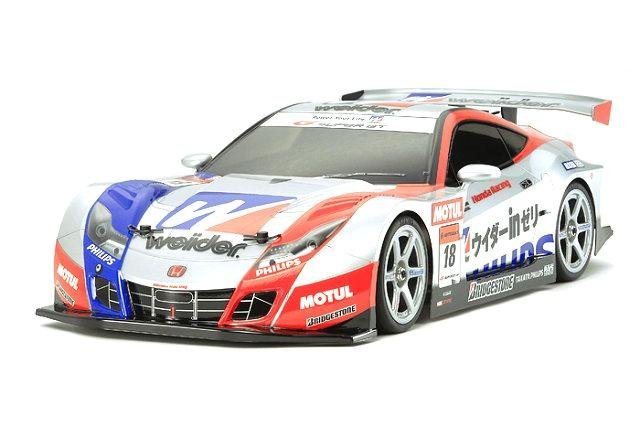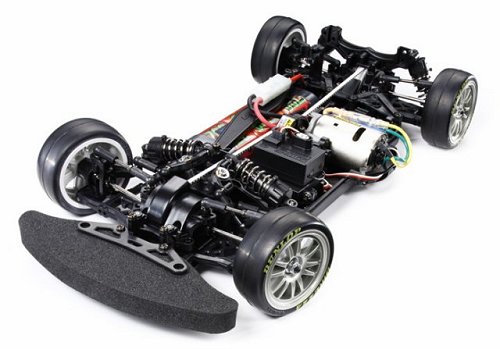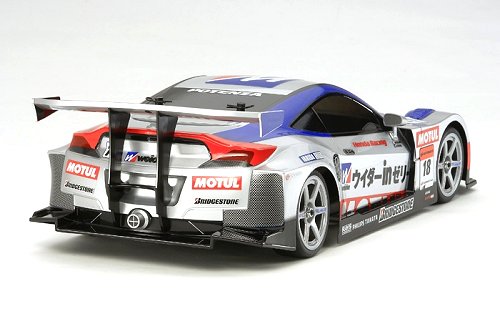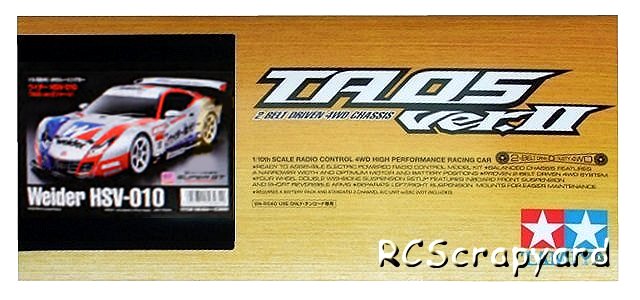

|


|
Tamiya Weider HSV-010 - 58484
|
Released by Tamiya on February 23, 2011, this TA05 Ver.II Chassis self assembly Radio Controlled model, is of the Team Weider Honda HSV 010 that won the GT500 class championship in the 2010 Super GT series.
The Lexan body shell is a detailed representation of the cars sporting lines. Decals of the cars livery are included in the kit.

The TA-05 Chassis was first released in 2005 with a number of interesting innovative features, such as, ultra low centre of gravity and centrally mounted motor, spur gear and pulley plus matching front and rear pressure plate ball differentials and casings with equal length drive belts which kept production costs for Tamiya low and therefore maintenance costs for the owner as well.
2007 saw the introduction of the TA-05 IFS (Inboard Front Suspension) version, employing a lay-down shock system mounted behind the front gearbox to allow for lower nosed body shells and in 2009 the IFS was updated, the difference being a narrower chassis, re-designed motor mount and a number of other parts from the TRF-416X. The chassis was re-launched as the TA-05 Version II.
Personally, I found the lay-down shocks a pain to set up for varying track conditions. However, a conversion kit is available.
To get the best from the Tamiya TA-05 Ver II Chassis, it needs to be fine tuned to hug the corners at high speed, without slipping off the track and accelerate smoothly under control. Small adjustments can make a Big difference and our simple to understand, step by step procedure, will guide you to the best Set-up for your driving style.








|
|
|

|
|
Tamiya Weider HSV-010 #58484 TA-05 V2 - Chassis
 |
|
Tamiya Weider HSV-010 #58484 TA-05 V2
 |
Buying a Used Tamiya Weider HSV-010
|









|






|
|
|

|
Hints, Tips and Information
Rubber Tires for RC Models
Rubber Tires ALWAYS should have either soft sponge or rubber inserts. They will not function as they should without them. And if you are totally serious about your racing they should be glued to the rims. How to Mount Rubber Tires onto Wheels/Rims.
Before mounting your Tires, I would recommend talking to the more experienced racers at your local club, concerning what inserts they use. Even the top level racers rely on a bit of local knowledge on tracks they have never raced before. |
|
Hints, Tips and Information How to Charge Rechargeable Batteries for Peak PerformanceNi-Cad (Nickel Cadmium) Batteries
1/ All Ni-Cad Batteries have to be Discharged soon after use. This is to avoid the dreaded "Memory" effect that on subsequent re-charges can cause a momentary drop in performance during a race. A simple discharger can be made from a car 12v bulb.
Ni-Mh (Nickel Metal Hydride) Batteries
1/ Never charge Ni-Mh batteries at a current higher than 4.5 amps. Although these batteries can give a higher voltage than Ni-Cad Batteries, they are much more sensitive and easy to damage if charged too quickly. |
|
RC Models:
|
Radio & Motors: |
Other
Accessories: |